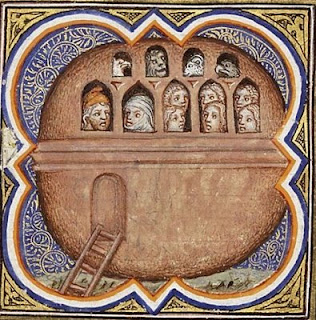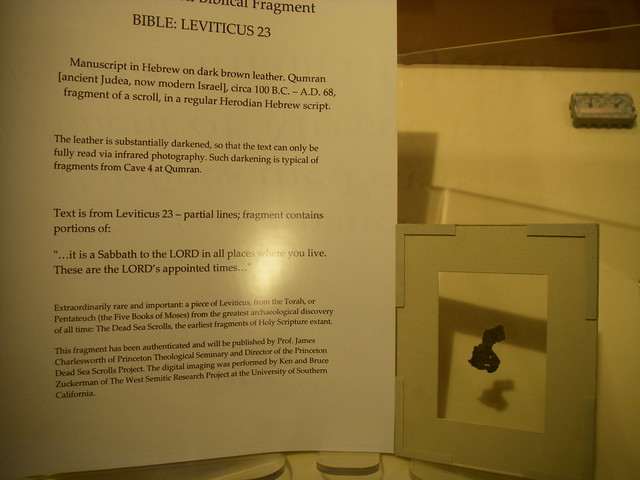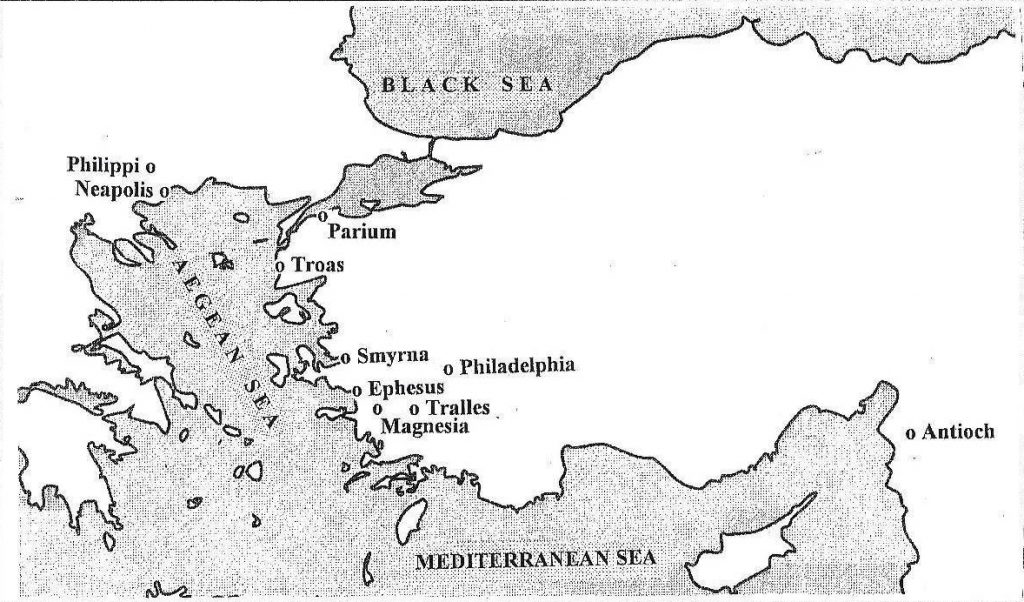Roger Parvus has updated his Part 4 Letters Supposedly Written by Ignatius of Antioch post.
2011-07-31
#4 update – Letters supposedly written by Ignatius of Antioch

Musings on biblical studies, politics, religion, ethics, human nature, tidbits from science

Roger Parvus has updated his Part 4 Letters Supposedly Written by Ignatius of Antioch post.


René Salm has shared his findings on the historical roots of the term we know as Nazarene. The pdf file, The Natsarene and hidden gnosis, is available on the mythicist resources webpage.
This is from the forward of the 20-page article:
This lengthy Addendum follows the third installment (Chapters 3–4) of my translation from the German of Ditlef Nielsen’s book, The Old Arabian Moon Religion and the Mosaic Tradition (1904). . . . [That book] explores a number of still novel themes which are foundational to my thought, such as: the influence of North Arabian religion on early Israelite origins, and in turn on Christianity; the gnostic nature of the religion of Midian, where Moses allegedly sojourned and learned from Jethro; and the gnostic character of the most ancient Israelite religion.
. . . . In the Addendum, I show that these terms [Nazarene and Nazoraean] reflect the Semitic n-ts-r (nun-tsade-resh), a root with specifically gnostic connotations going back to the Bronze Age. The dictionary tells us that Hebrew natsar means “watch, preserve, guard.” Its cognates in related Semitic languages also signify “secret knowledge” and “hidden things.” . . . .
. . . . . For perhaps the first time, we can now see that Natsarene (or a close cognate, with Semitic tsade) was widely used in early Middle Eastern religions to designate the person of advanced spirituality, a spirituality linked to hidden gnosis. Hence the title of the Addendum, “The Natsarene and hidden gnosis.” . . . .
The table of contents: Continue reading “The origin and meaning of Nazarene/Natsarene and its relationship to “hidden gnosis””

This continues from Part 1 where I began discussing what Richard Horsley has to say about popular messianic movements in Israel up to the time of Jesus in Bandits, Prophets & Messiahs. Previous posts addressed the concept of a future messiah among the literate elites. This post considers what Horsley has to say about the way messianic movements among the general populace grew out of the ancient popularity of the institution of kingship. I have only two reservations about Horsley’s argument:
(1) ancient Israelite kingship, especially the stories of popular elections of kings, was mostly biblical myth without historical basis;
(2) Horsley can do no more than assume that there was widespread messianic hope among the masses – he offers “little or no evidence” for this. The primary evidence he does offer is the sudden outburst of rebellions at the death of Herod and again prior to the war with Rome. He believes that such rebellions are evidence that messianic hopes had lain “dormant” in the minds of the people for many generations up to those times.
So the evidence is very thin. In my last post on this topic I referred to William Scott Green’s claim that evidence for messianic hopes up till the Jewish rebellion of 66-70 is not unlike a proof-texting exercise. It has long been assumed there must have been such a hope in order to make sense of “a historical Jesus.”


Corrected and updated -- Neil Godfrey, 1:15 pm 30th July 2011
Comment by Steven Carr — 2011/07/29
It is interesting to see how mainstream scholars are edging towards mythicist ideas.
http://nearemmaus.com/2011/07/28/the-future-of-historical-jesus-studies/
‘The old idea that exalted epithets such as “Son of God” or “Son of the Most High” applied to Jesus reflect Greco-Roman thinking, rather than Jewish thinking, has been seriously challenged by the Aramaic fragment, 4Q246, in which an eschatological figure is described with these very terms. Moreover, the idea of a Messiah figure, whose appearance brings healing, resurrection of the dead, and good news for the poor—concepts that define the identity and ministry of Jesus—is now attested in 4Q521. Indeed, the idea of a figure who acts in the very place of Yahweh himself, in fulfillment of Isaiah 61 and an expected eschatological jubilee, is attested in 11QMelchizedek.’
Curiously James McGrath claims all Messiah figures were expected to be conquering kings.** (Note by Neil: McGrath has clarified that he is only referring to “Davidic Messiahs” and he does not dispute that there were other messianic notions among the Jews.)
And Mike Wilson is adamant that no Jew could have thought of a figure acting in the very place of Yahweh himself (unless that figure was a crucified criminal, if I understand Mike correctly. )
It is interesting that mainstream scholars claim that mythical eschatological figures, people who never actually existed, are described in the same terms applied to Jesus.
The texts are available online, but for easy reference I copy the relevant ones here, with links to the site sourced:
“[X] shall be great upon the earth. [O King all (people) shall] make [peace], and all shall serve [Him. He shall be called the Son of] the [G]reat [God], and by His Name shall He be hailed (as) the Son of God, and they shall call Him Son of the Most High like a shooting star.”
4Q521 Continue reading “The Messiah in the Dead Sea Scrolls — how like the Gospel Messiah”

On René Salm’s site is this notice of an online review of David Fitzgerald’s book about Jesus mythicism:
· David Fitzgerald, “Ten Beautiful Lies About Jesus” (2010) PDF. This essay received an Honorable Mention in the 2010 Mythicist Prize contest (since discontinued). It reviews the case for Jesus mythicism in an easy-to-read style and is a good starting point for those new to the subject of Jesus mythicism. Fitzgerald has expanded the essay into a book, Nailed: Ten Christian Myths that show Jesus Never Existed at All. A review of the book is here.
“Here” is the “Official MU SASHA blog” — Missouri University Skeptics, Atheists, Secular Humanists and Agnostics. Nice to see a candle of reason in Missouri.

 I’m thinking of the true believer who believes in another reality as more real than the real world here and now.
I’m thinking of the true believer who believes in another reality as more real than the real world here and now.
The lawyer for Breivik has said his client appears to be insane because he is convinced that “only he understands the truth”. The rest of the world, he believes, will understand him 60 years from now. He has a completely different perception of reality, for instance believing torture exists in Norway’s prisons.
If that is insanity, then how do we describe those who believe the whole world lies in wickedness under the rule of the Devil while only they understand the truth? Or those who believe that Jesus will return in only a few years and demonstrate his favour to them before the whole world, to show the world that they were the ones who were right all along? Or what of those who believe in behind-the-scenes 666 world-takeover conspiracies, weird things about atheists, Catholics, Muslims, gays, the beneficence of the treatment of Bradley Manning, or weapons of mass destruction?
Breivik kills people but true believers don’t do that, do they? Breivik, we are told, used drugs and other aids to help him keep his nerve through it all. True believers don’t do that, but when acting as part of a much bigger institution upon which they can hang their personal responsibilities, like a nation or national government, they have been known to actively support mass murder, torture and other forms of systemic violence.
And on a personal level how many are prepared to “suffer persecution” for their willingness to cause heartache by forsaking and breaking up their families, removing themselves from healthy social intercourse, allowing loved ones to die from treatable illnesses, covering up sexual abuse for the “greater good”, all “for Christ”. And what of those who really are prepared to sell everything, lose or leave their jobs, all in the belief that they are soon going to be “taken away” to a better place?
I’m so thankful I got out of the true believer status myself. And so thankful I did not go the way of some of my former friends who likewise left but only turned to other brands of “true believer”. I have wondered why some other ex-fundamentalist atheists come across as so bigoted and arrogant when speaking of those who are still trapped in the same place they once were themselves. What happened to growth in self-understanding? I think the Wikipedia article on Eric Hoffer’s book might give us a clue:
With their collapse of a communal framework people can no longer defeat the feelings of insecurity and uncertainty by belonging to a compact whole. If the isolated individual lacks vast opportunities for personal advancement, development of talents, and action (such as those found on a frontier), he will seek substitutes. These substitutes would be pride instead of self-confidence, memberships in a collective whole like a mass movement, absolute certainty instead of understanding.

In response to Dr James McGrath’s post on Mythicism and Peer Review Earl Doherty wrote the following:
Jim, you are a piece of work. I only wish that your mindless animosity toward the idea that, just possibly, the Christian record could represent something which two thousand years of hidebound and confessionally-driven tradition could never have brought itself to envision, was a rarity. But you are legion, and such animosity is hardly a dispassionate, scientifically founded position. Your counters to my arguments have been consistently naïve and pathetically lame, misunderstanding and misrepresenting my case, loaded with emotional prejudice and just about every fallacy in the book. And you’ve now added that voice to the farcical question of peer review.
This idea of “peer” review is a joke in NT scholarship. The latter is a closed and privileged club, with boundaries that cannot be crossed (witness the failure of The Jesus Project), and no journal or publisher within that field is going to give mythicism the time of day. There would be no more possibility of an unbiased and effective review of a mythicist’s work than what you’ve given mine, and mythicists know that. You know it as well. The very idea that centuries of scholarship could have been based on a serious misinterpretation of the record is so abhorrent even to so-called critical scholars (there may be the rare exception, Mack or Ludemann for example), that no honest review is possible. You’ve shown that. And considering that people like you represent a good part of the general readership of such journals and publications, no journal or publication would risk the firestorm they would create in accepting and publishing mythicist viewpoints.
An interested party (not a mythicist) in the U.S. several years ago offered The Fourth R publication of Westar/the Jesus Seminar a donation of $5000 if they would devote part of an issue to mythicism, consisting of an article by myself presenting my case and a rebuttal article by any scholar of their own choosing. They turned it down. Continue reading “Mythicism and Peer Review”

Revised 31 July 20:30 CST — see shaded paragraphs
4th post in the series by Roger Parvus. The complete series is archived here.
TDOP = The Death of Peregrinus by Lucian. Harmon’s translation here.

In my previous post I argued that the so-called letter to Polycarp was originally a letter from Peregrinus to the man who, after restoring order in the church of Antioch, had been installed as that church’s new bishop. The letter was one of three that the prisoner wrote after learning that the dissension in the church in Antioch had come to an end. In the other two letters – those addressed to Smyrna and Philadelphia – he urgently requested that Ambassadors of God be appointed to go to Antioch to rejoice with that church. In the so-called letter to Polycarp, on the other hand, there is an urgent request for the convocation of a most God-pleasing council and, in connection with it, the appointment of a Courier of God. This most God-pleasing council, I maintain, was convened in Antioch – not Smyrna — and it is one and the same with the gathering mentioned in Lucian’s TDOP that drew delegates “even from cities in Asia to succour, defend and encourage” the would-be martyr Peregrinus. The letters to Philadelphia, Smyrna and to Polycarp purport to have been written from the port city of Troas while the prisoner was waiting to board ship. But, as we will see shortly, they were probably written while he was waiting at a different port.
The other letters in the collection – to Ephesus, Magnesia, Tralles and Rome — were written before the prisoner knew the outcome of the in-fighting at Antioch. Because the four letters in this group would have been written at least a few days before the three letters in the other group I will refer to them, for the sake of brevity, as set 1 and will call the others set 2.
The set 1 letters were written in Smyrna during a stop there by the prisoner’s military escorts. The bishops of three of the churches addressed by those letters – Ephesus, Magnesia and Tralles – had traveled, accompanied by a few other members of their flocks, to visit with the prisoner at Smyrna. The letters written to their churches were likely carried back by them when they made their return trips. I see no serious reason to question that these three letters were in fact addressed to the churches they purport to address. I cannot say the same about the other set l letter: Romans.


Dr McGrath’s review of Chapter 9 of Doherty’s book Jesus: Neither God Nor Man conveys no idea to the uninformed reader what the chapter is about. So to make up that lack (surely scholarly reviews should give readers some clear idea of what exactly is being reviewed!) I outline the content of the Doherty’s chapter here in the process of responding to McGrath’s review, and in particular to a fundamental misreading on McGrath’s part that resulted in his post being an unfortunate travesty rather than a serious review.
In chapter 8 Doherty had argued that Paul’s source for his understanding of the gospel and Christ was primarily revelation through the Jewish scriptures. In chapter 9, the chapter being discussed here, Doherty addresses another influence that guided Paul’s interpretation of those scriptures – the dominant philosophical and theological ideas in the Hellenistic and Jewish worlds of his day.
(Where there are any quotations in bold type that is entirely my own emphasis — not Doherty’s. All or most of the scripture references are hyperlinked to see the full text. )


In online discussions and posts about “historical method” in connection with the study of Jesus and early Christian history I often encounter confusion about what history really is. New Testament scholar Scot McKnight notes that this confusion begins with many biblical scholars themselves:
In fact, the historiography of historical Jesus scholars is eclectic and often unconscious or uninformed of a specific historiography. (p. 20, Jesus and His Death)
An uninformed view of history is that it is “just one damned thing after another.” But a list of events and dates is really more like a chronicle or almanac. If one’s experience of history stopped in early high school then it is understandable for one to think this sums up what history is all about.
My introduction to some sort of philosophy of history was E. H. Carr’s What Is History? He startled me as an undergraduate by thinking to ask “What is a historical fact?” I had always taken “historical facts” for granted and it had never crossed my mind that there could be a question about it.
And I think a number of New Testament scholars who think they are doing history when they research and write about the historical Jesus would profit from grappling with the question. Continue reading “What is history? What is a historical fact?”


This post surveys the evidence and questions the conclusions of Richard A. Horsley (with John S. Hanson) in Bandits, Prophets & Messiahs: Popular Movements in the Time of Jesus (1999) concerning messianic hopes and movements among the common people of Palestine up to the time of Jesus. It is some years since I first read this book, and my own views have since been modified by my studies of the contributions of “minimalism” (mainly through Thompson, Lemche and Davies) to what we can securely know about the history of Palestine in the centuries up to the Christian era. So it is interesting to return to Bandits, Prophets & Messiahs with that new understanding and to read the arguments again through more informed – and more critical – eyes.
In a couple of recent posts I shared Horsley’s presentation of the evidence we have for the understanding of literary elites on the concept of “messianism” (and “Davidic messianism”) up to the early first century CE. Horsley rightly stressed the “other-worldly” theological nature of these ideas and how removed they probably were from the masses. While Horsley emphasized that these ideas were unrelated to popular ideologies, I am now embarrassed to have to say I did overstate his position on what the peasant masses did have on their minds. I had allowed by the subsequent reading of ‘minimalist’ methodologies to interfere with what I recalled of his argument, and I have to now confess that he really did claim that the masses did have some “dormant” messianic hopes after all that were activated around the time of Jesus. (I will have to return to my earlier posts and re-write a few lines.)
But in my defence I will show in this post that Horsley’s assertion here is comparable to the assertions of scholars who concede that the gospels are so overlaid with myth, theology and literary artifices that they bury from view any historical Jesus, but we have to believe there was a historical Jesus behind it all just the same. Horsley’s evidence for popular messianic hopes supposedly unlike anything we find in the elite literature of the period rests squarely upon the assumption that the Old Testament stories of Judges and Davidic Kings were genuine historical eras. The link Horsley attempts to forge between those times and the period of Jesus is, I will argue, unnatural, speculative and without unequivocal evidence.


This was forwarded to me by Mozer Zimmo (the alcanaanite blog).
Friends,
I received the below invitation from the Palestinian General Delegation in Ottawa announcing a “Briefing Session by Dr. Hanan Ashrawi” who is visiting Canada as special envoy of President Mahmoud Abbas. I believe you all know Dr. Ashrawi; a world-renowned spokesperson for the Palestinian cause. If there is one person you would want to hear articulating the case for the Palestinian people in a highly sophisticated and civilized manner, it would be Hanan Ashrawi. Her briefing is not an event you would not want to miss. Continue reading “For Ottawa readers with an interest in Palestine”


A Jewish professor at the Hebrew University in Jerusalem, Galit Hasan-Rokem, has argued that the Gospels grew out of a Jewish folklore-midrashic tradition. The Gospels are not written as folklore so there are obvious differences. And midrash has a variety of applications, but in general it is a Jewish approach interpretations of the scriptures that can be applied to a number of different literary genres with different purposes and for different audiences. The intent is to inject new meanings into scriptures, often by applying them to newly created stories or new experiences within the Jewish communities.
So the distinctive feature of midrash is a weaving of passages from scripture into stories or commentaries (or other) to explore new meanings for them. I will discuss the nature of midrash more fully in a future post, and will include one of the best explanations/definitions of it that I can find — a small passage by James L. Kugel in his book, In Potiphar’s House: The Interpretive Life of Biblical Texts. This will show more explicitly the extent to which the Gospels have been influenced by Jewish midrashic thought and style.
Thomas L. Brodie wrote a small book demonstrating the way the Gospels structured much of their narratives of Jesus around the stories of Elijah and Elisha, but did not like to use the word midrash. The reason was not because midrash was wrong, but because it was too general to be particularly useful. The gospels needed a narrower definition to capture their nature. But clearly the midrashic ways of Jewish writing are found throughout the Gospels.
Rather than discuss midrash as it was known to ancient Jews and the specific similarities with many features in both the Gospels and epistles of Paul, I will just post “on record” two examples of midrashic literature applied to the folklore genre. They are from Galit Hasan-Rokem’s final chapter in Web Of Life: Folklore and Midrash in Rabbinic Literature in which she discusses three midrashic tales about the Messiah.
This way I will have something online that I can refer to when I do discuss the topic in a little more depth. But remember the following are midrash at work in folklore tales. The Gospels are not the same genre as folklore, but we do find the same midrashic features in them, i.e., retelling old scripture passages and biblical stories in new ways.

If you follow the “it is ignorant to say there is no evidence for the HJ” discussion on Debunking Christianity you have already read most of what I post here.
John Loftus kicks things off with his OP in which he says:
I want to put to rest the ignorant claim that “There is no evidence for a historical Jesus.” There most definitely is. It’s called “confirming evidence” or evidence of things we would expect to find if there was a historical Jesus, and it is Legion.
Let’s have done with such an ignorant claim.
The debate is whether there is sufficient evidence.
I responded with an attempt to clarify what I see as a common but fundamental misunderstanding embedded in this comment. I joined the discussion late and wrote:
Beginning with the OP I believe we are confusing two quite distinct concepts: evidence and sources. I think this is one of the factors that leads to so much confusion and talking past one another.
It was once almost uniformly accepted by Old Testament scholars that the OT was “evidence” for a historical united kingdom of David and Solomon.
But a number of scholars beginning not too many decades ago attempted to point out that a mere claim, a mere story, might be a source of information, a claim, about historical events, but it is hardly the same as evidence for them.
These scholars turned to the way historical studies of ancient times were conducted by nonbiblical historians and drew clear distinctions between primary evidence (evidence physically belonging to the period in question: bricks in the ground, graffiti on an original wall, in the case of most ancient history) and secondary evidence: that which is physically subsequent to the events in question. The guiding principle was that primary sources must always take precedence and the secondary must be interpreted through the hard evidence of the primary.
But obviously in the case of Jesus we have no primary evidence, only secondary. Continue reading “Who says, “There is no evidence for the historical Jesus” ?”